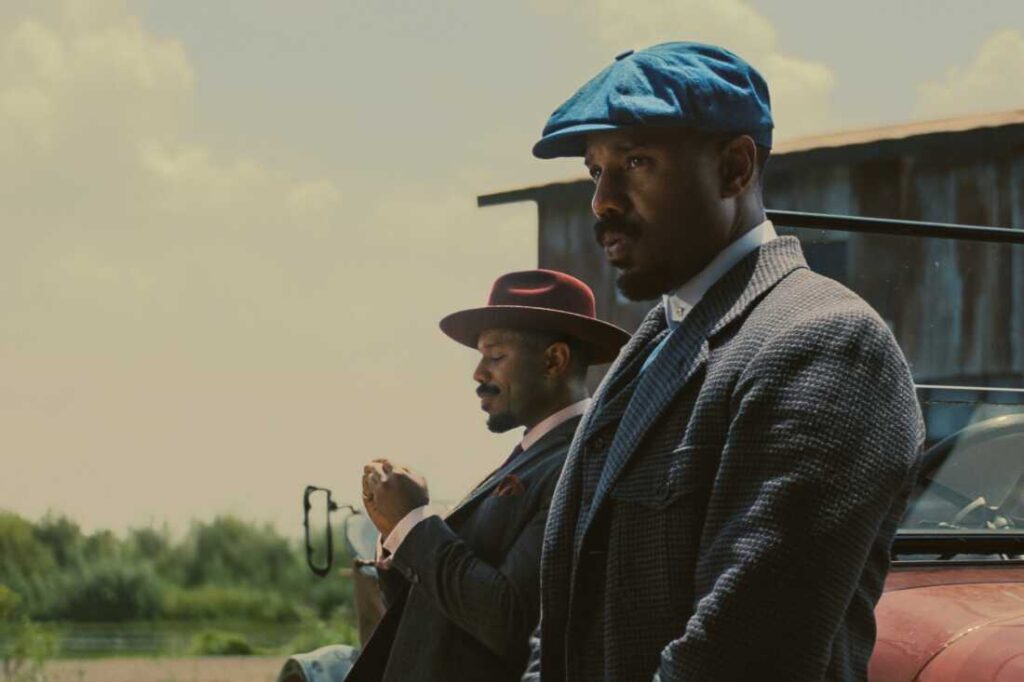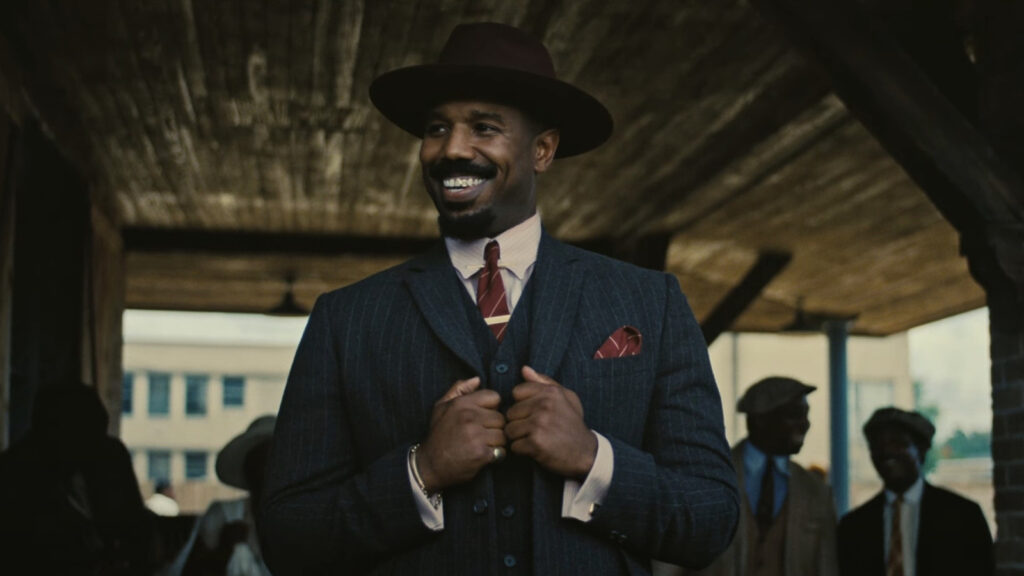
We always say we want more original movies, but how many movies are truly original? Sinners, the latest feature from Ryan Coogler, is in some ways a work of pastiche, incorporating strains of gangster cinema, music videos, and horror lore. But despite embracing its influences (which is not, in itself, a bad thing), it manages to feel new—both for the urgency of its ideas and the vibrancy of its filmmaking.
That description also applied, with partial force, to two of Coogler’s earlier efforts, Creed and Black Panther. In those pictures, the director managed to imprint his personality onto the material while still operating within the brand-managed confines of the cinematic franchise. (His attempt to repeat the feat with Black Panther’s sequel, Wakanda Forever, was markedly less successful, if partly for tragic reasons beyond his control.) Sinners, for all its boisterous entertainment value, shackles him with no such commercial chains. No longer is Coogler reinterpreting and revitalizing a cherished piece of intellectual property. He’s reimagining the world.

Perhaps more importantly, he is reuniting with his male muse. That would be Michael B. Jordan, the mercurial movie star who’s appeared in all of Coogler’s films besides Wakanda Forever (where his absence was keenly felt). He plays both Elijah and Elias Moore, though everyone refers to them as the Smokestack twins, with each embodying one half of the moniker. Costume designer Ruth Carter (who won Oscars for both Black Panther flicks) helps you distinguish between the two—Smoke tends to wear a blue newsboy cap, while Stack dons a maroon fedora—but Jordan instantly vaporizes any concerns of misidentification, imbuing each character with a distinct personality. Smoke, the more cautious of the pair, is a skilled negotiator who exudes lethality but also patience; by contrast, Stack is vivacious and impetuous, a ladies’ man who enjoys discussing his cunnilingus technique and whose inconstant ways have drawn the ire of Mary (Hailee Steinfeld), an ex-lover who’s none too pleased to see him back in town.
That town would be the Mississippi Delta, where the prodigal brothers have returned in 1932 after working for Al Capone in Chicago. Flush with cash they may or may not have pilfered from the Windy City underworld, the twins barter with a suspicious white landowner (David Maldonado) who totally isn’t in the Klan. His bigotry trumped by his greed, he agrees to sell them a sawmill, which they plan to immediately convert into a juke joint. And the first part of Sinners, beyond its ominous flash-forward opening that hints at occult entities stalking a gospel church, resembles a caper film crossed with a Muppet movie. Smoke and Stack resolve to assemble a crew—a motley and talented group of musicians, artisans, and assorted specialists—for the express purpose of putting on a show.

This setup allows Coogler to develop a loose, playful vibe, even as he applies confident, lissome craft. Smoke visits the main square, where he teaches an awestruck girl the art of haggling before convincing a general-store owner to supply him with goods; when he asks the young cashier to go find her mother (Li Jun Li, who memorably sang “My Girl’s Pussy” in Babylon), the camera follows her out of the shop and across the dusty street before backpedaling as her target makes her way to the store—a quiet moment of visual mastery. Not that everything is elegant: When Smoke catches a potential thief sniffing around his truck, he blows off the poor guy’s kneecap, establishing that this protagonist is not your typical virtuous hero.
Stack is no less deadly, but he’s more fun to be around, and his jovial demeanor is what convinces Slim (Delroy Lindo) to play piano at the brothers’ nascent establishment. Slim shares Stack’s buoyant swagger, but his elder-statesman stature informs Sinners with a sense of Black history; in a sneakily extraordinary scene, he recounts the past lynching of an old friend, and the soundtrack softly adopts the howls and cries of the incident, lending this rambunctious movie an air of anguished melancholy.
Yet the twins’ most important recruit, both narratively and thematically, is Sammie (newcomer Miles Caton), a young blues guitarist whose pastorly father (Saul Williams) warns him that music is a force of seductive evil. He’s at least half-right. The film’s opening voiceover informs us that certain artists are so gifted, they can summon the souls of musicians from different eras. It’s a vivid metaphor that Coogler brilliantly literalizes during a sequence at the club, when Sammie’s knockout performance somehow morphs into a centuries-spanning medley, complete with African drums and electric guitar, the camera swooping and soaring through the ecstatic crowd. It’s exhilarating.

It isn’t the only moment of concert-style euphoria; in some ways, Sinners functions as a diegetic musical, featuring a number of lively scenes of singing, strumming, and dancing. (The versatile, effervescent score is by Ludwig Göransson.) But it also occupies a decidedly different genre, one that the spoiler-averse should avoid discovering (though the second trailer of course discloses it). Quite simply: It’s a vampire movie.
The integration of a supernatural element gives Sinners a juicy kick, even as it nudges the film toward more recognizable territory. The chief villain is an Irish bloodsucker named Remmick (Jack O’Connell, enjoying himself), who conspires with fellow racists to overwhelm the twins’ bar and weaponize Sammie’s wizardry for their own ends. Coogler delivers some killer images—the shot of Remmick hovering in midair behind an unsuspecting Mary provides a delicious jolt—but he must also make room for the usual mythological exposition about invitations and vulnerabilities. (Most of this is supplied by Wunmi Mosaku, who plays Smoke’s semi-estranged wife and who previously battled various monsters on Lovecraft Country.) And the cacophonous violence of the third act, with its armada of fangs and splashes of gunfire, can’t help but feel familiar, recalling the freewheeling chaos of undead thrillers like Underworld and From Dusk Till Dawn.

Yet even if the movie’s assaultive action verges on generic (a problem that occasionally plagued Black Panther and severely hampered its sequel), its horror angle generates surprising thematic power. Vampirism can serve as an allegory for many things: repressed sexuality, youthful liberation, moral rot, what have you. In Sinners, the bad guys’ malevolence carries a dimension that’s both racial and cultural. It isn’t just that Remmick and his white thugs want to subjugate a defiant Black citizenry. It’s that they want to assimilate the juke joint’s passionate creativity into their own traditions, erasing its identity in the process. The foulness of white supremacy is beyond dispute, but Remmick’s more surreptitious goal is to transform a thriving sect of popular art into a monoculture.
This is a provocative conceit, and one that Sinners, by virtue of its very existence, emphatically rejects. It’s a proudly original picture that makes no apologies for the thorniness of its ideas, and it substantiates itself through its own vigor and intelligence—including a mid-credits scene that grapples with fraternal loyalty, human decency, and the endurance of its own medium. At multiple points, Sammie is seen clutching the remnants of a broken guitar, and the message is clear. Those vampires may spill blood, but they can’t drain this movie of its fighting spirit.
Grade: A-
Jeremy Beck is the editor-in-chief of MovieManifesto. He watches more movies and television than he probably should.
